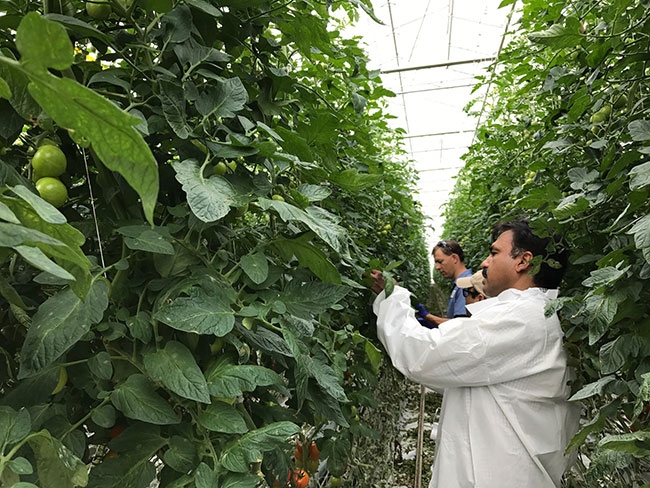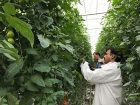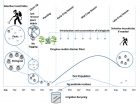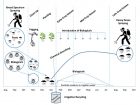
News
Year-Round Performers
Biocontrols are effective with greenhouse vegetable crops in any season.
September 5, 2017 By Dr. Abida Nasreen
 Pest scouting is a primary IPM tool.
Pest scouting is a primary IPM tool. September 2017 – If you are a sports person, you may know that no coach heads into the fourth quarter without a proper plan. Late-season vegetable IPM needs the same approach.
Use all your players to maintain crop health during early- and mid-season, but use the best one for late season use. This player should be able to handle the late-season pest pressures while maintaining the quality production and conserving the beneficial fauna for the next crop.
“Insecticide” is a best player for some growers – most greenhouses use it to control pests and keep plants protected. The rationale?
- “There’s nothing wrong in pushing the crop for few months, so why spend more money on natural enemies.”
- “We are pulling out the crop in few weeks, so why do we need to apply more bios when we can control the pests by a quicker and cheaper way.”
In my opinion, this is the worst player you could use, not only for the fourth quarter but also for the coming first quarter. You need to make a proper plan to keep this crop productive and for healthy start of next crop. The plan could be:
Biologically based pest suppression/ reduced use of chemicals. The preventive use of chemicals in greenhouse system is not recommended at all, such as the use of neonicotinoid insecticides to prevent pepper weevil. This did not help but instead caused resistance in thrips and disrupted biocontrol systems.
Spot treatment of badly affected areas by using selective pesticides is helpful; it is very true to control spider mites problem on all greenhouse crops. Never exceed the label rates, and it should be followed by at least two generous applications of Phytoseiulus persimilis with an interval of one week.
Add more natural enemies with the increasing pest pressure. This will keep pests under economic thresholds and help to manage the new crop early season.
If it is inevitable to apply a blanket treatment of pesticides, always choose the one less disrupting to the biological control program.
There is a common practice of application of non-selective pesticide at the end of crop cycle as a cleanup tool. However it is very much disruptive for the beneficial fauna of greenhouse ecosystem and highly contributing in the resistance phenomenon of many pests of economic importance.
Drenching pesticides could be the biggest reason biological control is unsuccessful in vegetable greenhouses where leachate is reused. Thus, those chemicals become a part of the irrigation water through the recycling system that may harm the establishment of various predators. As well, the sub-lethal doses may trigger resistance mechanism in the target pests.
Cleanup. Application of various chemicals (pesticides and disinfectants) could affect conservation of the beneficial insects, beneficial fungi, bacteria and viruses in the greenhouse system and may bring up the pest resistance problem quite quickly. Because the pests survived a heavy application of chemicals, they must be highly resistant and will reproduce faster as the new crop is placed in the greenhouse. Always use soft chemicals at the cleanup time to conserve beneficial biotic elements of the greenhouse system
Clean start. Ensure there are no weeds inside and that there is no plant debris at least one to two metres around the greenhouse. Avoid having algae in and around the greenhouse. Algae promote fungus gnat problems.
Preventive introduction of general predators. Apply the right biological control agent on the right crop and at the proper predator/prey ratio for pest prevention. For example: Dicyphus and Podisus for tomato crops; Swirskii and Orius in pepper crops; and Swirskii, Californicus and Podisus against the pests of cucumbers. Use banker plant systems such as Orius on ornamental peppers and Dicyphus on a mullein banker plant system.
Keep the banker plants well distributed throughout the cropping area.
Early introduction of the specialists (parasitoid / predator). Introduce Encarsia and Eretmocerus when the whitefly nymphs are noticed, apply Persimilis if spider mite is spotted, and release Aphidius if aphids are the problem.
Proper irrigation and balanced nutrients. Stressed plants are more vulnerable to pests and more prone to diseases. High nitrogen contents may make the plant very nutritious for the pest, low nitrogen contents of plant sap may cause heavy suction of plant juices by whiteflies and aphids to meet their need for amino acids resulting in them secreting more honey dews, stickiness and development of the sooty moulds.
Curative application of biologicals. If you are applying biocontrol agents for curative treatment, you have to be very generous. Release a good number of predators/parasitoids to treat the pest hotspots and affected areas. For example, use at least 250 D. Hesperus nymphs to handle whitefly or aphid on tomato crops; 500-1000 O. insidiosus are good for a thrips hotspot; 10K of P. persimilis to control a patch of spider mites, and 100-200 Aphidius wasps are good against aphids on all crops except tomatoes. For general application, apply the biocontrol agents according to the recommendations of your supplier.
Dr. Abida Nasreen is director of research and development with GrowLiv Ltd., www.growliv.com.
Print this page


